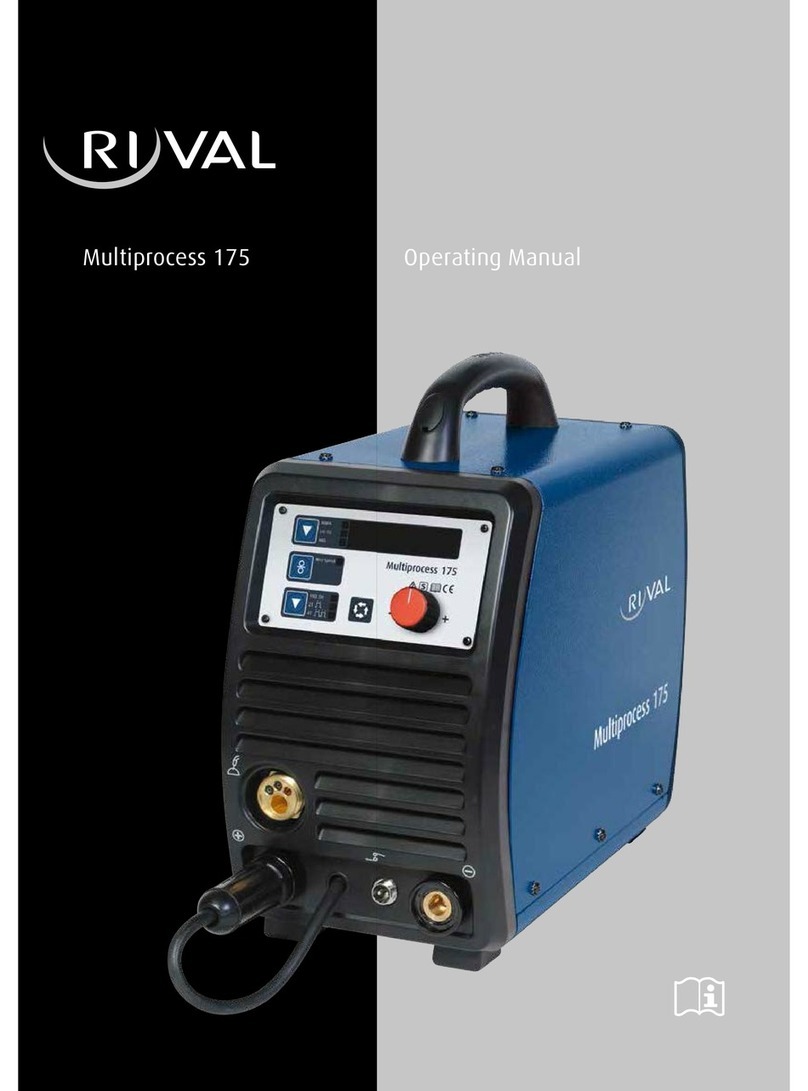06 07
EN
TIG 185 DC. Operating manual.TIG 185 DC. Operating manual.
1. Recommended safety precautions.
Clothing
Suitable clothing must be worn to prevent excessive exposure to UV
radiation and sparks. An adjustable helmet, flameproof loose fitting
cotton clothing buttoned to the neck, protective leather gloves, spats,
apron and steel capped safety boots are highly recommended.
Recommended filter shades for arc welding
Less than 150 amps
150 to 250 amps
250 to 300 amps
300 to 350 amps
Over 350 amps
Shade 10*
Shade 11*
Shade 12
Shade 13
Shade 14
* Use one shade darker for aluminium
1.3 Cylinder safety
1Cylinder valve hand-wheel, 2Back-plug, 3Bursting disc
Operator wearing personal
protective equipment (PPE)
in safe position
Backview of typical
cylinder valve
1
2
3
Ten points about cylinder safety
1. Read labels and Material Safety Data Sheet (MSDS) before use.
2. Store upright and use in well ventilated, secure areas away from
pedestrian or vehicle thoroughfare.
3. Guard cylinders against being knocked violently or being allowed to
fall.
4. Wear safety shoes, glasses and gloves when handling and connecting
cylinders.
5. Always move cylinders securely with an appropriate trolley. Take care
not to turn the valve on when moving a cylinder.
6. Keep in a cool, well-ventilated area, away from heat sources, sources
of ignition and combustible materials, especially flammable gases.
7. Keep full and empty cylinders separate.
8. Keep ammonia-based leak detection solutions, oil and grease away
from cylinders and valves.
9. Never use force when opening or closing valves.
10.Don’t repaint or disguise markings and damage. If damaged, return
cylinders to Ryval immediately.
Cylinder valve safety
When working with cylinders or operating cylinder valves, ensure that
you wear appropriate protective clothing – gloves, boots and safety
glasses. When moving cylinders, ensure that the valve is not accidentally
opened in transit.
Before operating a cylinder valve:
→Ensure that the system you are connecting the cylinder into is
suitable for the gas and pressure involved.
→Ensure that any accessories (such as hoses attached to the cylinder
valve, or the system being connected to) are securely connected.
A hose, for example, can potentially flail around dangerously if it is
accidentally pressurised when not restrained at both ends.
→Stand to the side of the cylinder so that neither you nor anyone else
is in line with the back of the cylinder valve. This is in case a back-
plug is loose or a bursting disc vents. The correct stance is shown in
the diagram.
When operating the cylinder valve:
→Open it by hand by turning the valve hand-wheel anti-clockwise. Use
only reasonable force.
→Ensure that no gas is leaking from the cylinder valve connection or
the system to which the cylinder is connected. Do not use ammonia
based leak detection fluid as this can damage the valve. Approved
leak detection fluid can be obtained from your Ryval supplier.
→When finished with the cylinder, close the cylinder valve by hand
by turning the valve hand-wheel in a clockwise direction. Use only
reasonable force.
Remember NEVER tamper with the valve. If you suspect the valve is
damaged, DO NOT use it. Report the issue to Ryval and arrange for the
cylinder to be returned to Ryval.
1.4 Electrical shock
→Never touch ‘live’ electrical parts
→Always repair or replace worn or damaged parts
→Disconnect the power source before performing any maintenance or
service
→Earth all work materials
→Never work in moist or damp areas.
Avoid electric shock by:
→Wearing dry insulated boots
→Wearing dry leather gloves
→Never changing electrodes with bare hands or wet gloves
→Never cooling electrode holders in water
→Working on a dry insulated floor where possible
→Never hold the electrode and holder under your arm.
1.5 User responsibility
→Read the Operating Manual prior to installation of this machine.
→Unauthorised repairs to this equipment may endanger the technician
and operator and will void your warranty. Only qualified personnel
approved by Ryval should perform repairs.
→Always disconnect mains power before investigating equipment
malfunctions.
→Parts that are broken, damaged, missing or worn should be replaced
immediately.
→Equipment should be cleaned periodically.
PLEASE NOTE that under no circumstances should any equipment or
parts be altered or changed in any way from the standard specification
without written permission given by Ryval. To do so, will void the
Equipment Warranty.
1.1 Health hazard information
The actual process of welding is one that can cause a variety of hazards.
All appropriate safety equipment should be worn at all times, i.e.
headwear, respiratory, hand and body protection. Electrical equipment
should be used in accordance with the manufacturer’s recommendations.
Eyes
The process produces ultraviolet rays that can injure and cause
permanent damage. Fumes can cause irritation.
Skin
Arc rays are dangerous to uncovered skin.
Inhalation
Welding fumes and gases are dangerous to the health of the operator
and to those in close proximity. The aggravation of pre-existing
respiratory or allergic conditions may occur in some workers. Excessive
exposure may cause conditions such as nausea, dizziness, dryness and
irritation of eyes, nose and throat.
1.2 Personal protection
Respiratory
Confined space welding should be carried out with the aid of a fume
respirator or air supplied respirator.
→You must always have enough ventilation in confined spaces. Be alert
to this at all times.
→Keep your head out of the fumes rising from the arc.
→Fumes from the welding of some metals could have an adverse effect
on your health. Don’t breathe them in. If you are welding on material
such as stainless steel, nickel, nickel alloys or galvanised steel,
further precautions are necessary.
→Wear a respirator when natural or forced ventilation is not good
enough.
Eye protection
A welding helmet with the appropriate welding filter lens for the
operation must be worn at all times in the work environment. The
welding arc and the reflecting arc flash gives out ultraviolet and infrared
rays. Protective welding screen and goggles should be provided for
others working in the same area.




























